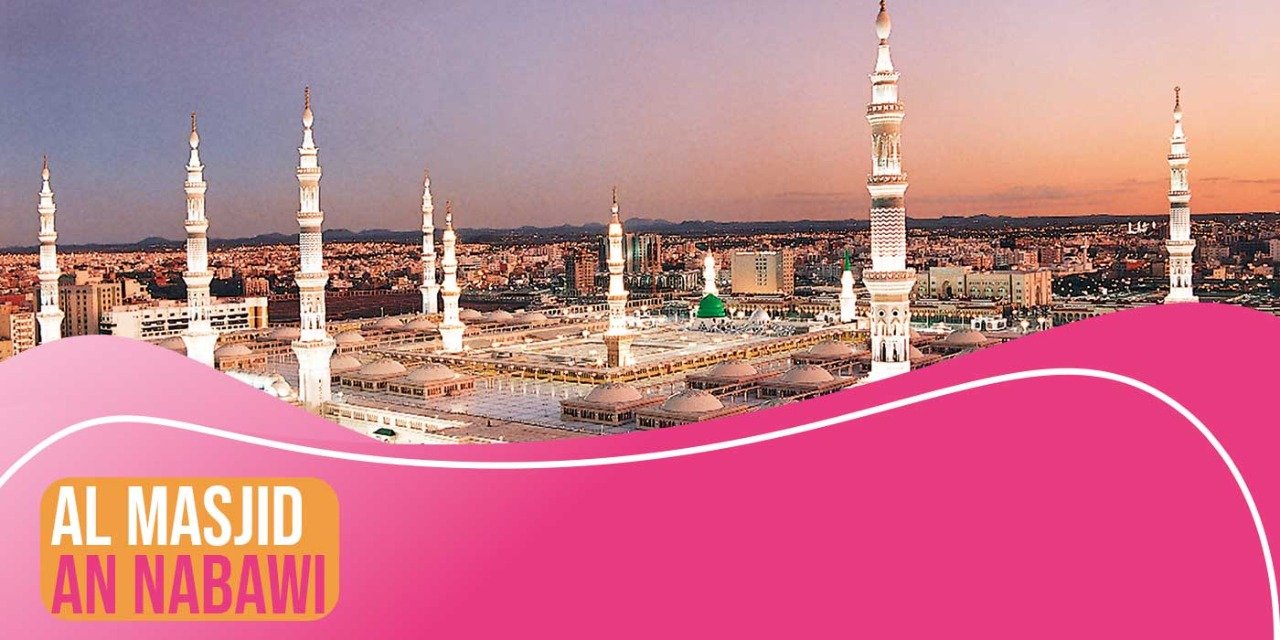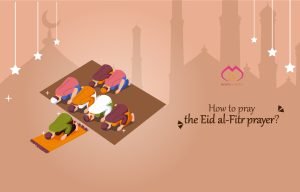Al masjid an Nabawi:
- Al masjid an Nabawi or The Prophet’s Mosque or the Prophet’s Sanctuary is one of the largest mosques in the world and the second holiest site in Islam (after the Grand Mosque in Makkah Al-Mukarramah).
- The mosque has undergone several expansions throughout history, going through the era of the Rashidun Caliphs and the Umayyad state, then the Abbasid and the Ottoman, and finally during the era of the Saudi state, where its largest expansion took place in 1994.
- The Prophet’s Mosque is considered the first place in the Arabian Peninsula to be lit by the use of electric lamps in 1327 AH corresponding to 1909.
- Counting the expansion carried out in Al masjid an Nabawi by Umar bin Abdul Aziz in the year 91 AH, Aisha’s room was entered into it, currently known as the “Honorable Prophet’s Chamber”, which is located in the southeastern corner of the mosque in which the Prophet Muhammad, Abu Bakr, and Umar bin Al-Khattab were buried, and the green dome was built over it.
- It is one of the most prominent landmarks of the Prophet’s Mosque.
- The mosque played a major role in political and social life, as it served as a social center, court, and religious school. The mosque is located in the center of Medina and is surrounded by many hotels and nearby old markets. And many people who perform Hajj or Umrah visit it and visit the tomb of the Prophet Muhammad, peace be upon him.
Stay tuned for our story about Al masjid an Nabawi.
Al masjid an Nabawi history:
- The Prophet Muhammad founded Al masjid an Nabawi in the first year of migration. The Prophet’s Mosque was the second mosque to be built in the city, which was known as Yathrib before the migration. It was preceded by the Qebaa Mosque, according to what Saif al-Rahman al-Mubarakfuri says in his book “The Sealed Nectar.”
- The mosque, which contains the “garden of paradise,” as described in many Islamic books, is now located within the Prophet’s Mosque Al masjid an Nabawi, which lived for dozens of centuries and expanded beyond the boundaries of the old city.
- According to Islamic tradition, a prayer in the Prophet’s Mosque Al masjid an Nabawi is better than a thousand prayers performed in any other mosque, except for the Grand Mosque Alkaaba Almosharafah.
- In its current state, after centuries of expansion, the mosque contains the tomb of the Prophet Muhammad and the tombs of the caliphs Abu Bakr al-Siddiq and Omar ibn al-Khattab. It also contains the homes of the Prophet’s wives, in addition to Al Rawda AL Sharifah.
- It was mentioned in Sahih al-Bukhari on the authority of Abu Hurairah that the Prophet Muhammad said, “Between my house and my pulpit is a garden from the gardens of Paradise.”
- The mosque Al masjid an Nabawi was built in 632 AD, next to the residence of the Prophet Muhammad – that is, 1441 years ago – but it has undergone many renovations and expansions since then. The largest of these renovations was carried out by the Saudi King Abdullah bin Abdul-Aziz, and it continues to this day.
- It is believed that if the expansions currently underway are completed, the mosque – which is visited by millions of visitors annually – can accommodate about 1.8 million worshipers at one time.
Al Masjid an Nabawi architecture:
- The minarets of Al masjid an Nabawi are architectural landmarks and the legacy of the Prophet’s Mosque since ancient times. The minarets of the Prophet’s Mosque are adorned with unique architectural beauty, and they can be seen from all sides, distinguished by their Islamic architectural identity.
- Minarets have been known since the beginning of the era of the Prophet, peace, and blessings be upon him when Bilal bin Rabah was calling the call to prayer from the roof of the nearest house to the mosque.
- Al masjid an Nabawi went through several expansions throughout history, and the minarets of the Prophet’s Noble Mosque in the first Saudi architecture 1370-1375 AH became four beacons, as the northwestern minaret, the northeastern minaret, and the Bab al-Rahma minaret were removed, and two minarets were built in their place, one in the northeastern side, and the other on the other side. Northwestern and the constructions of the lighthouses in the first Saudi expansion are distinguished by the architectural aesthetic shape, as each lighthouse has a depth of (17 m) and a height of (70 m).
- Each minaret consists of four floors, the lower first floor is designed in the shape of a square, continues above the roof of the mosque, and ends with congelation bearing a square balcony above, and the second floor is octagonal, where it is decorated with arches that end in the shape of triangles, and ends at the top with congelation topped with a balcony, while the third floor was designed in the form of It is round, almost the same height as the second floor, ornamented with colored rhinestones, and ends with congelation, the top of which bears a circular balcony.
- The fourth floor (the jusaq) is raised slightly, as the fifth floor was made in the shape of a polygonal helmet that ends in a semi-conical shape, topped by an onion dome, and ends at the top with congelation also surmounted by a balcony.
Scroll down for more about Al masjid an Nabawi.
Al masjid an Nabawi facts:
10 facts about Al masjid an Nabawi:
- When the Prophet, may Allah’s prayers and peace be upon him, built the mosque for the first time, the area of the mosque was (1050 square meters).
- The Prophet may Allah’s prayers and peace be upon him made an expansion of the mosque, so the area became (2475 square meters).
- During the era of the Righteous Caliphs, it expanded twice, during the era of Amr bin Al-Khattab and Othman bin Affan, “may God be pleased with them,” until its area reached (4071 square meters).
- The Umayyad state, the Abbasid state, and the Mamluk state expanded the Prophet’s Mosque more than once until its area reached (9010 square meters).
- During the era of the Ottoman Empire, it was expanded twice, and its area became (10,303 square meters).
- The first to grant Al masjid an Nabawi a beacon was the first caliph in Islam, Amr bin Abdelaziz, and this happened to be a substitute for the Muezzin ascending to the roof of the mosque to perform the Azzan to call for the prayer.
- When building Al masjid an Nabawi at the beginning, the Messenger, may Allah bless him and grant him peace, made three doors (on the western side, on the eastern side, and the southern side). And after the revelation of the Qiblah change in the second year of Hijra from Al-Aqsa Mosque to the Sacred Mosque “Al Masjed Al Haram; The southern door, which was facing the old Qiblah for Muslims, was closed, and a door on the northern side opened in its place.
- Number of doors has increased, and their locations changed several times with the multiplicity of countries and various incidents, until the latest expansion of the Saudi state, and the number of current doors has become (41 main doors).
- The mosque currently accommodates (698,000 worshipers), adding what the courtyards can accommodate as well, but they may reach more than that, but the mosque’s yards only accommodate the number (430,000 worshipers), and you can notice the columns spread inside the mosque and their number of is (151 columns).
- The virtue of praying in the Prophet’s Mosque Al masjid an Nabawi is considered as the virtue of a thousand prayers in any other mosque, except for the Grand Mosque. The Messenger, may Allah’s prayers and peace be upon him, recommended that when visiting the Prophet’s Mosque, enter with your right foot.
Hope you enjoyed our Article about Al masjid an Nabawi and wish we all visit Al masjid an Nabawi soon.
Hope you enjoyed our article:
- Murouj Academy is an Islamic Academy for Islamic studies and other Islamic courses. As an online Islamic academy, Murouj provides many Islamic courses such as the Quran memorization course, standard Arabic course, Quran tajweed, Ijaza recitation course, and Islamic Studies course.
- The Interpretation of Dreams in Islam is not the end Check more Blogs.





